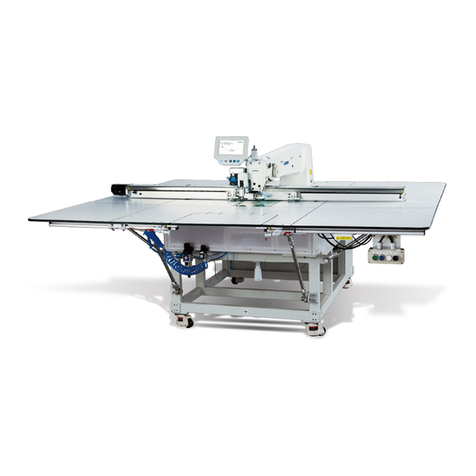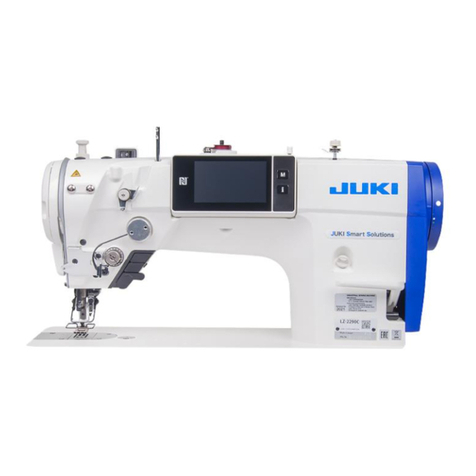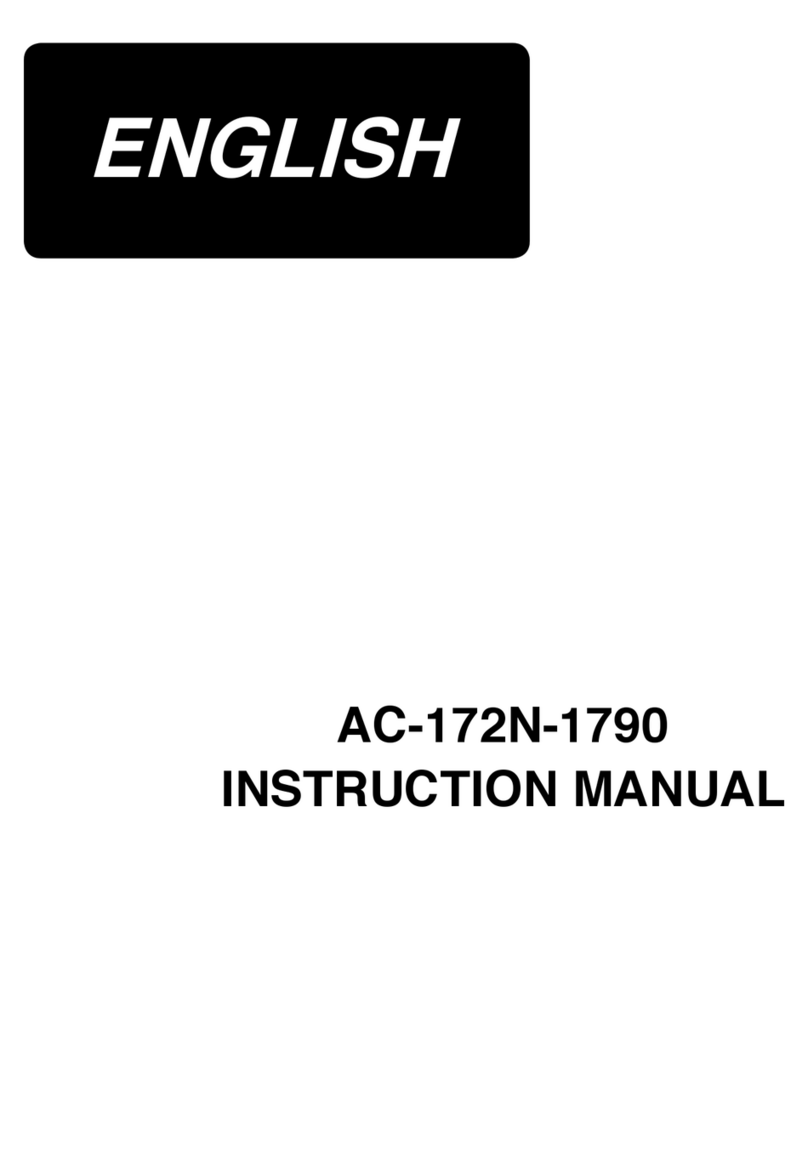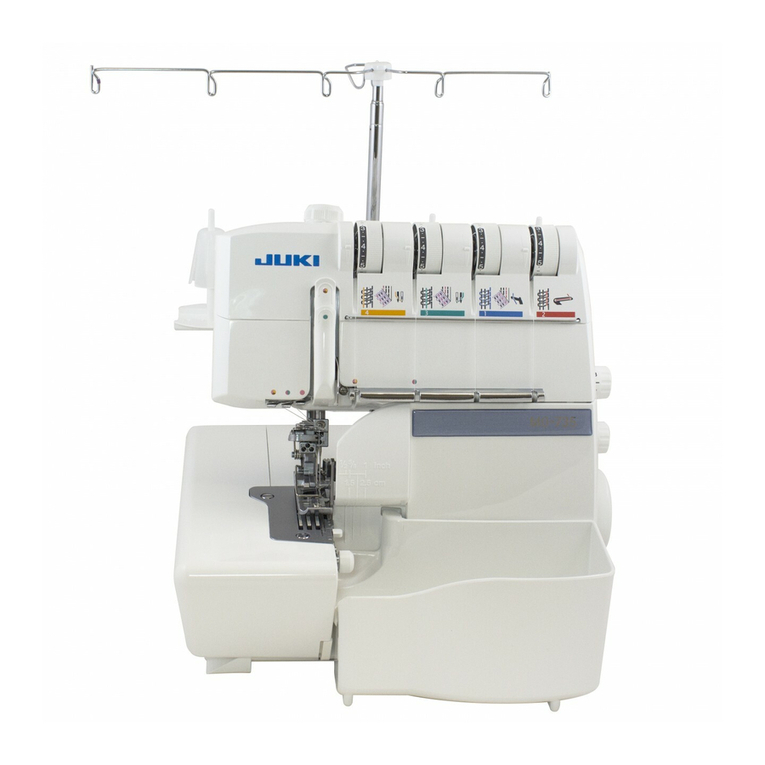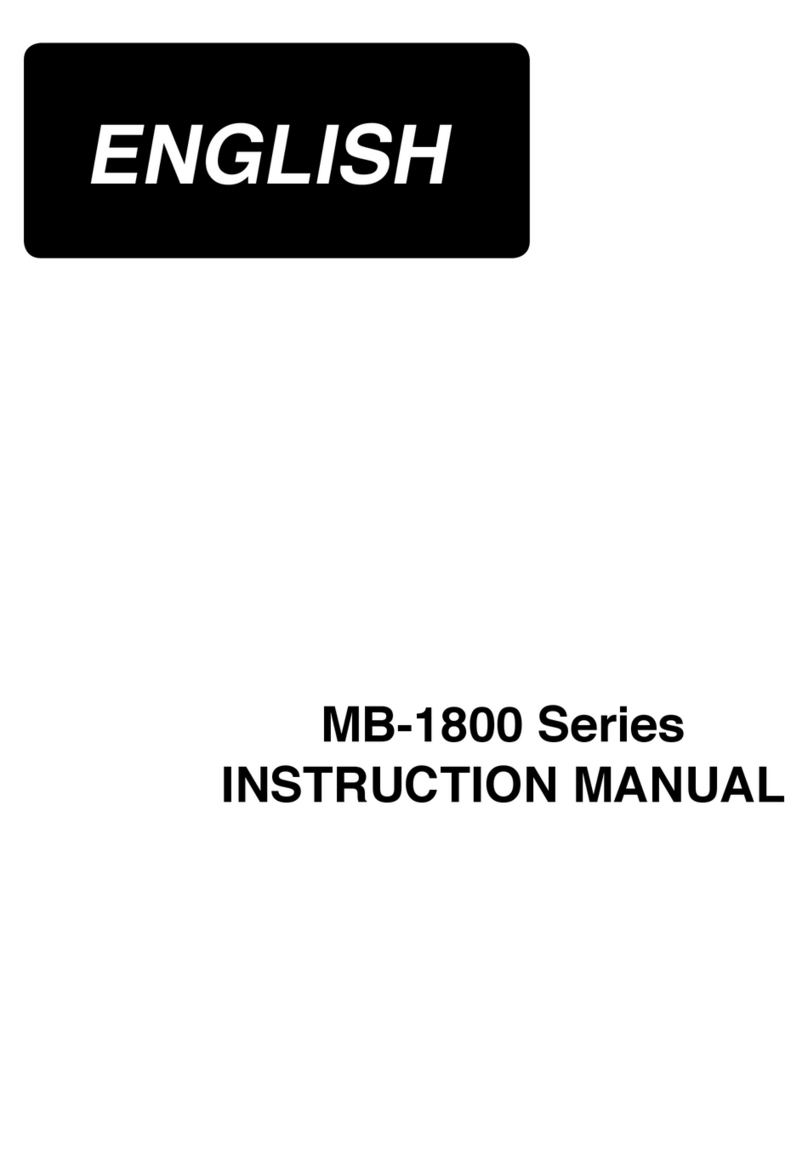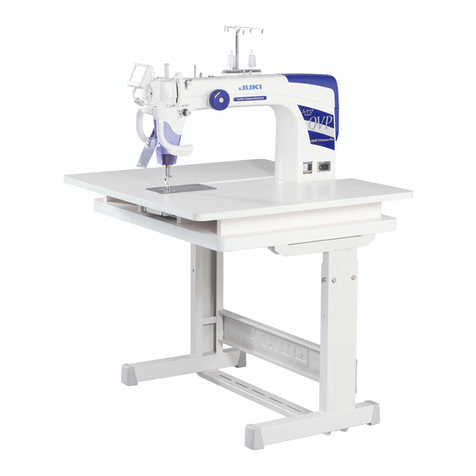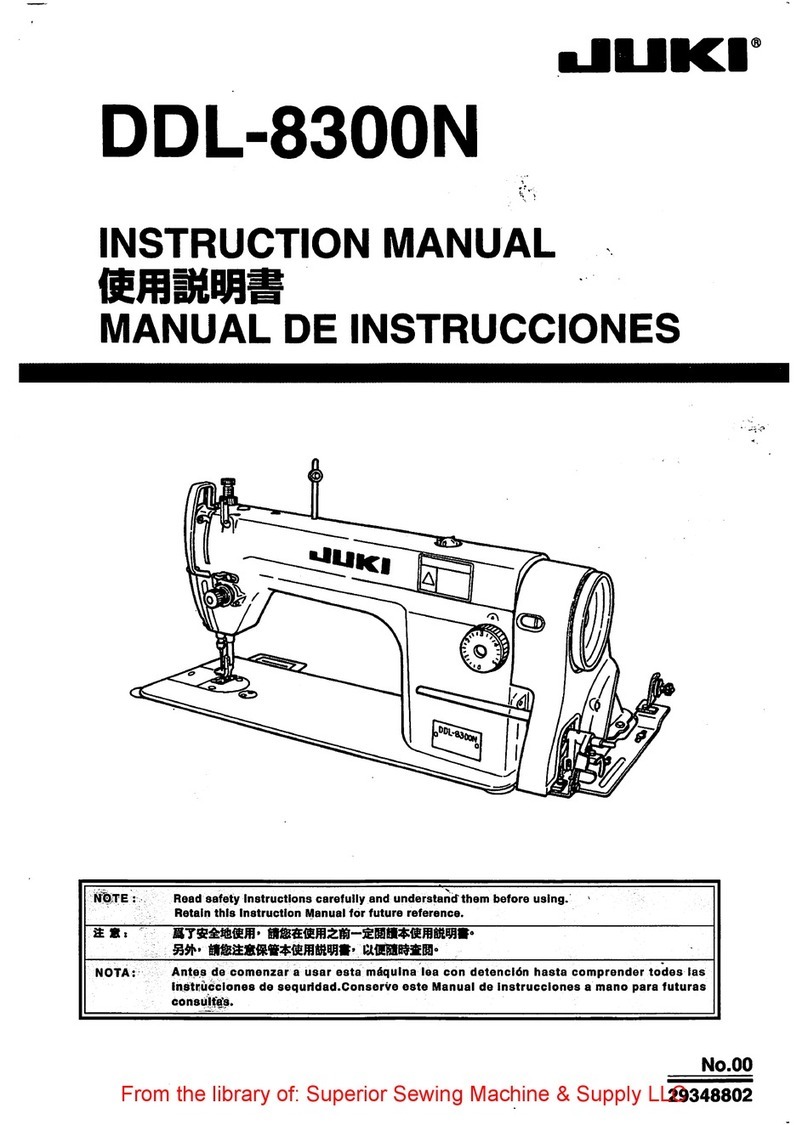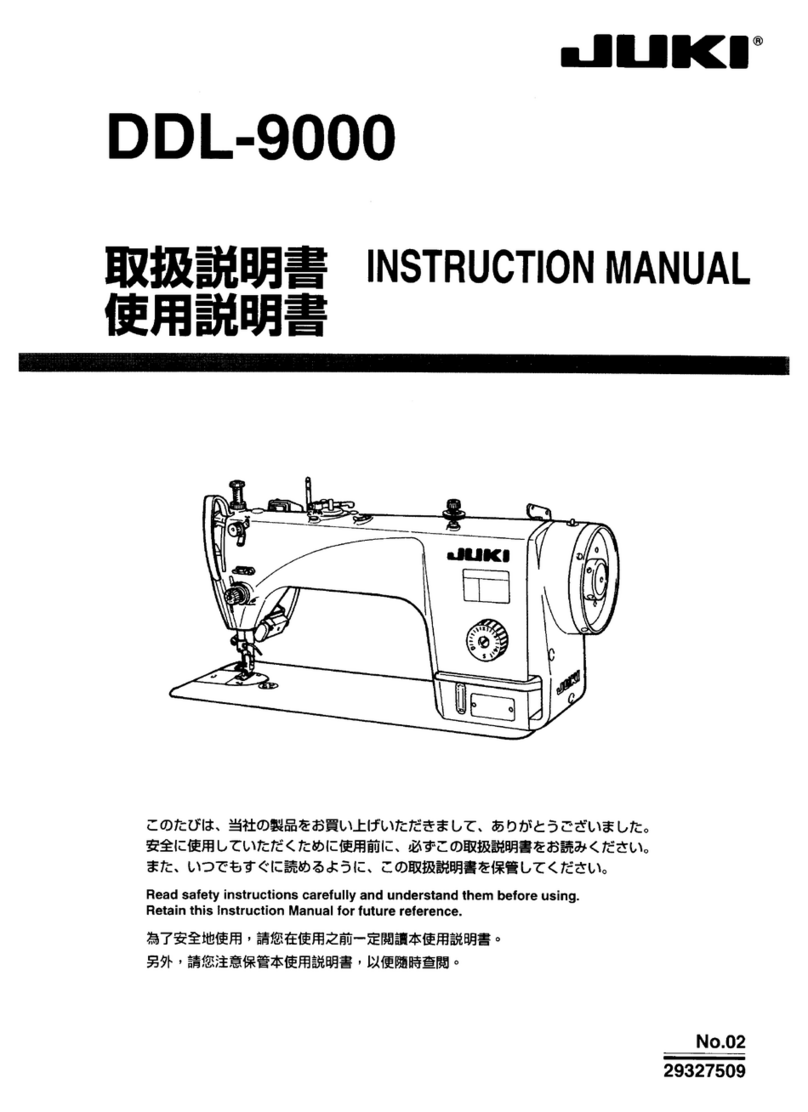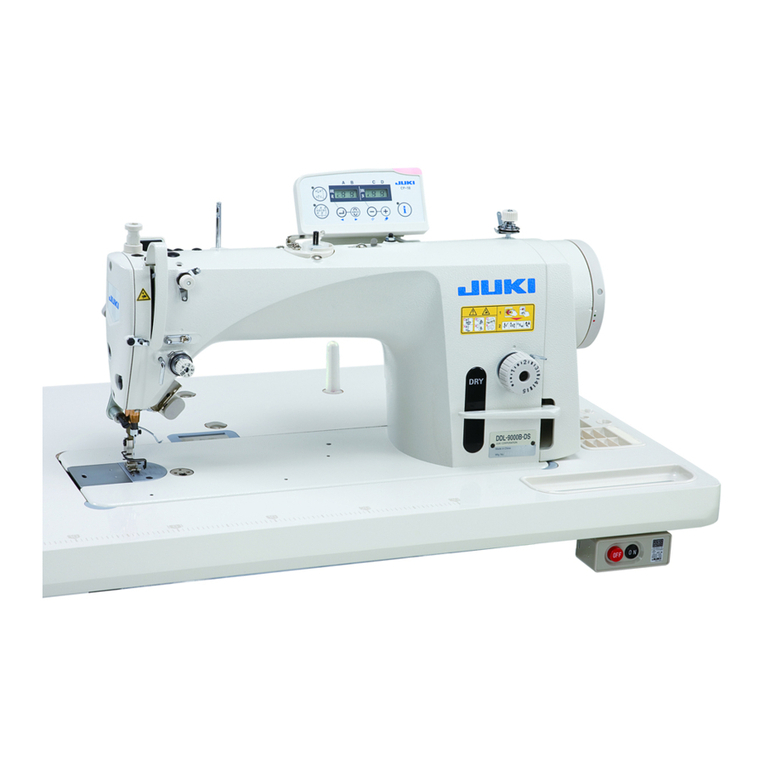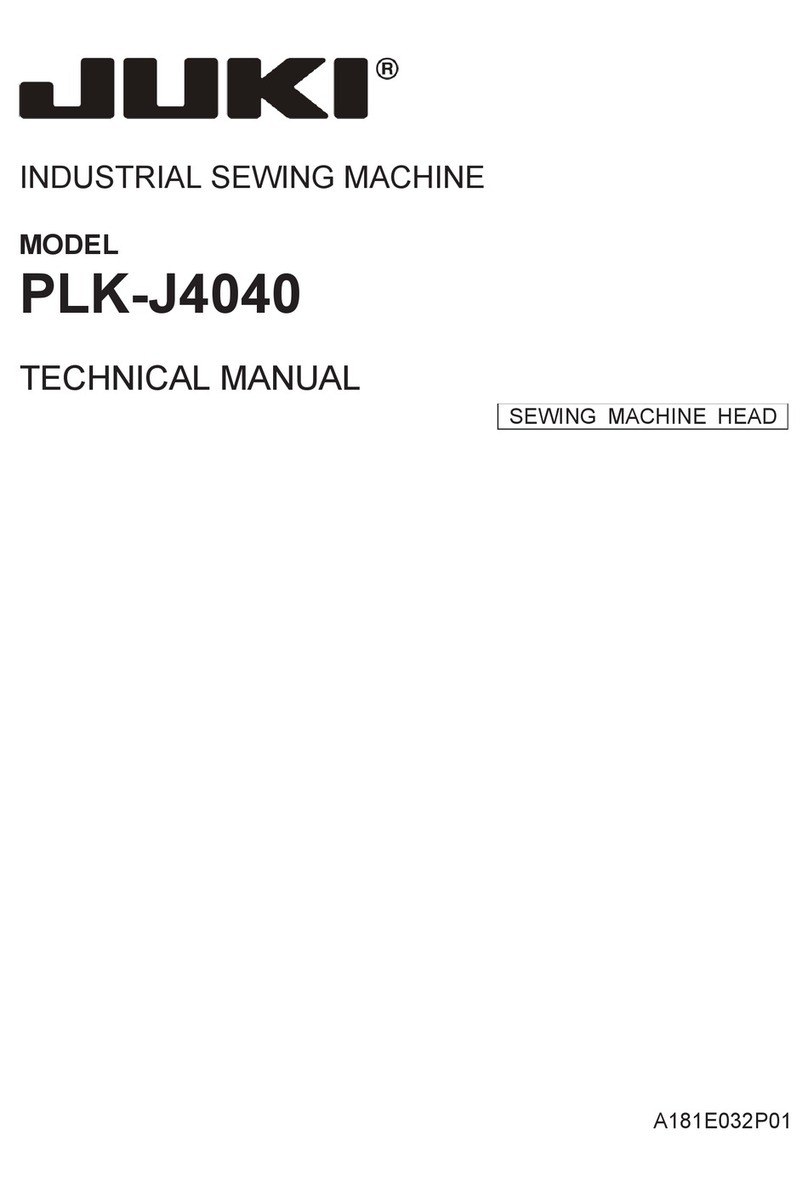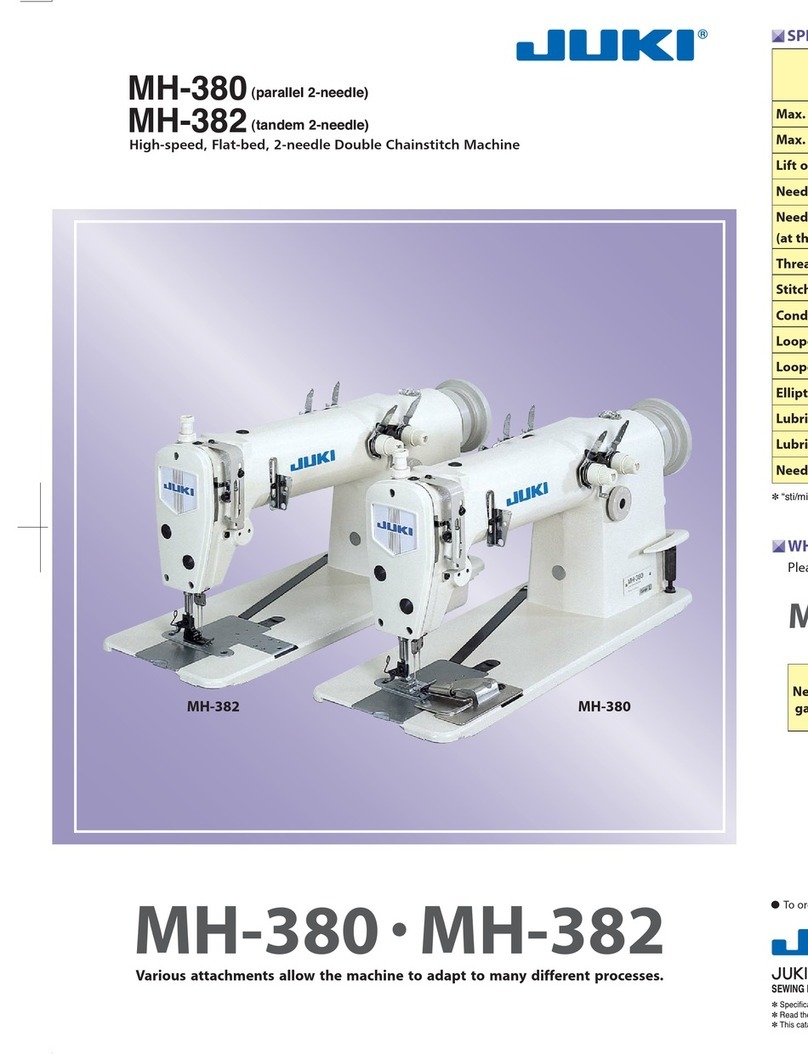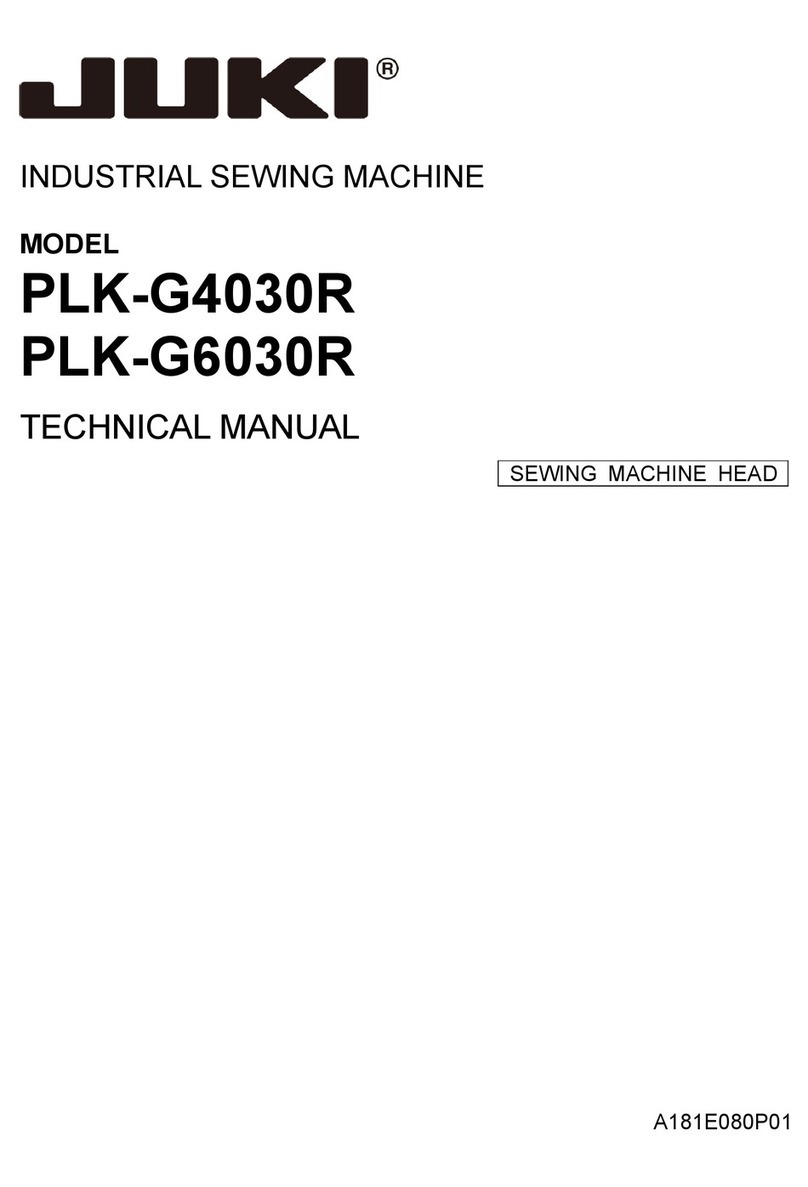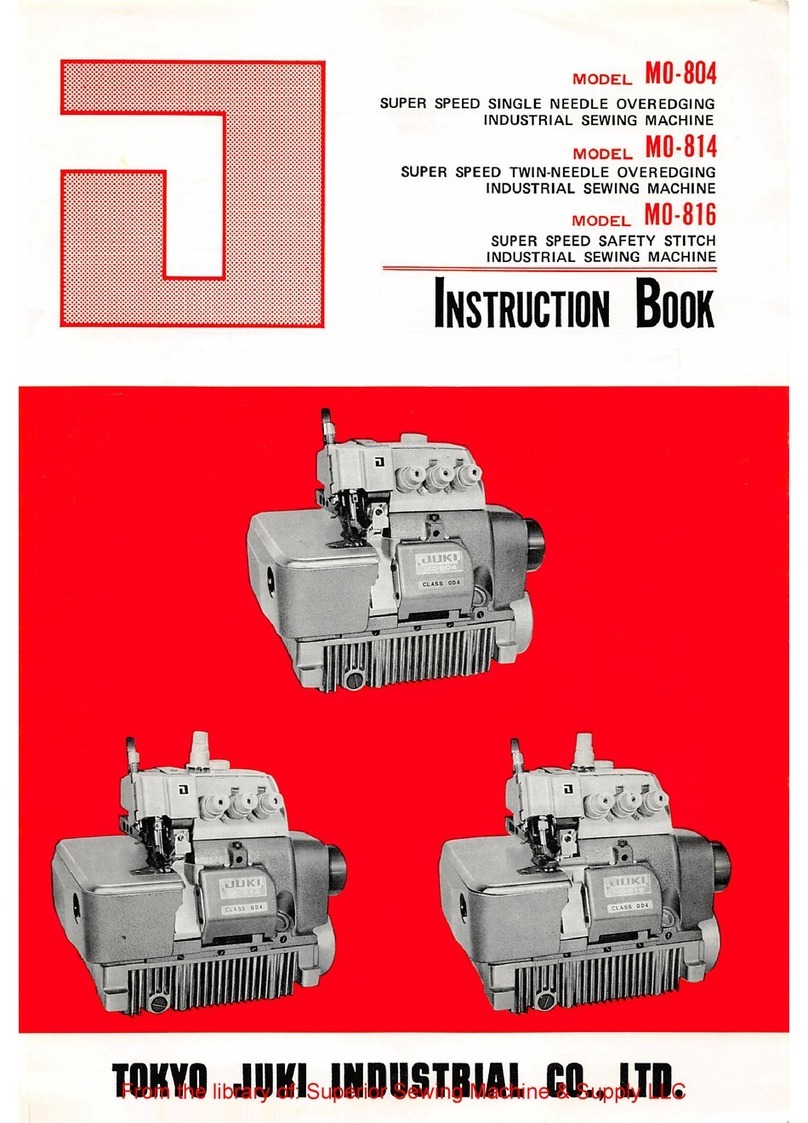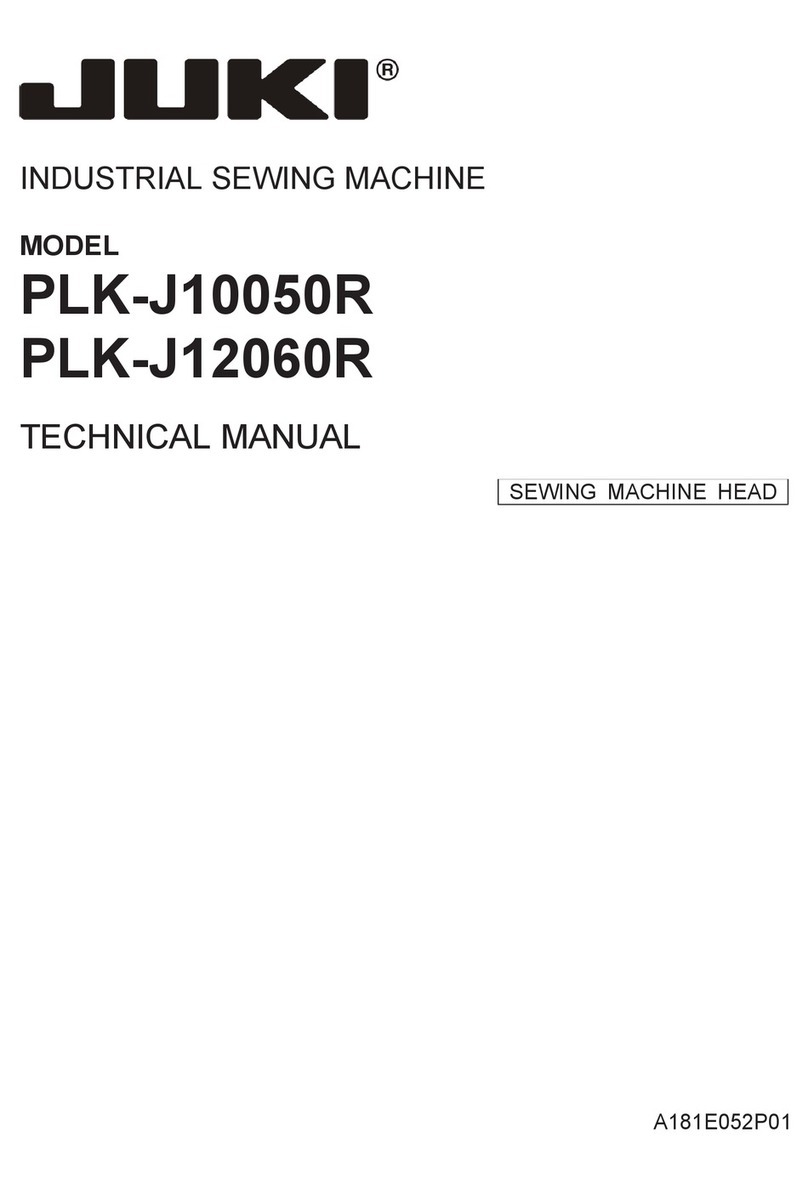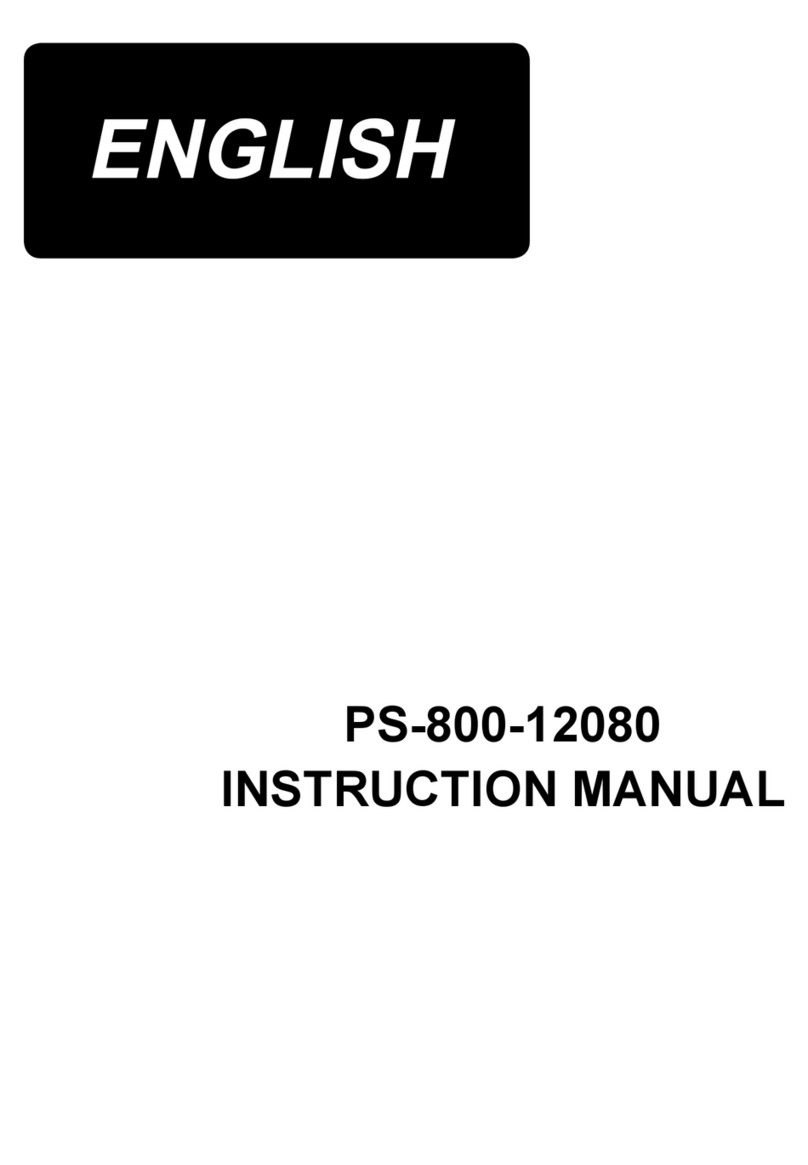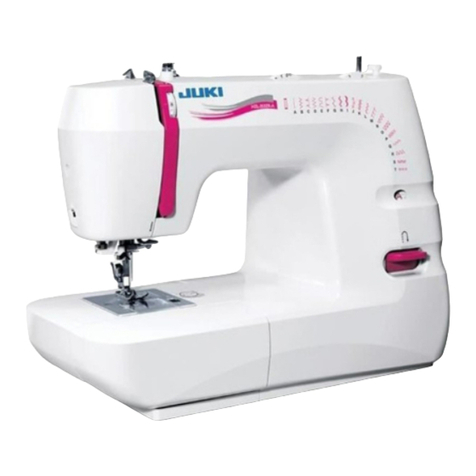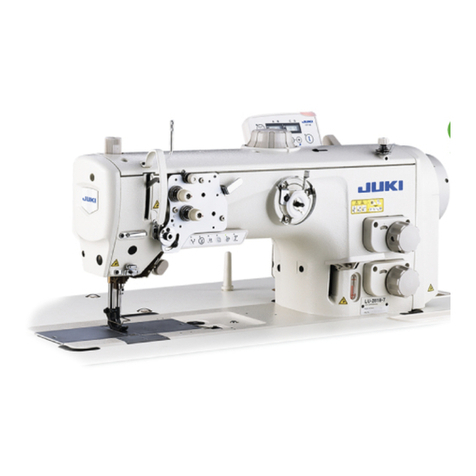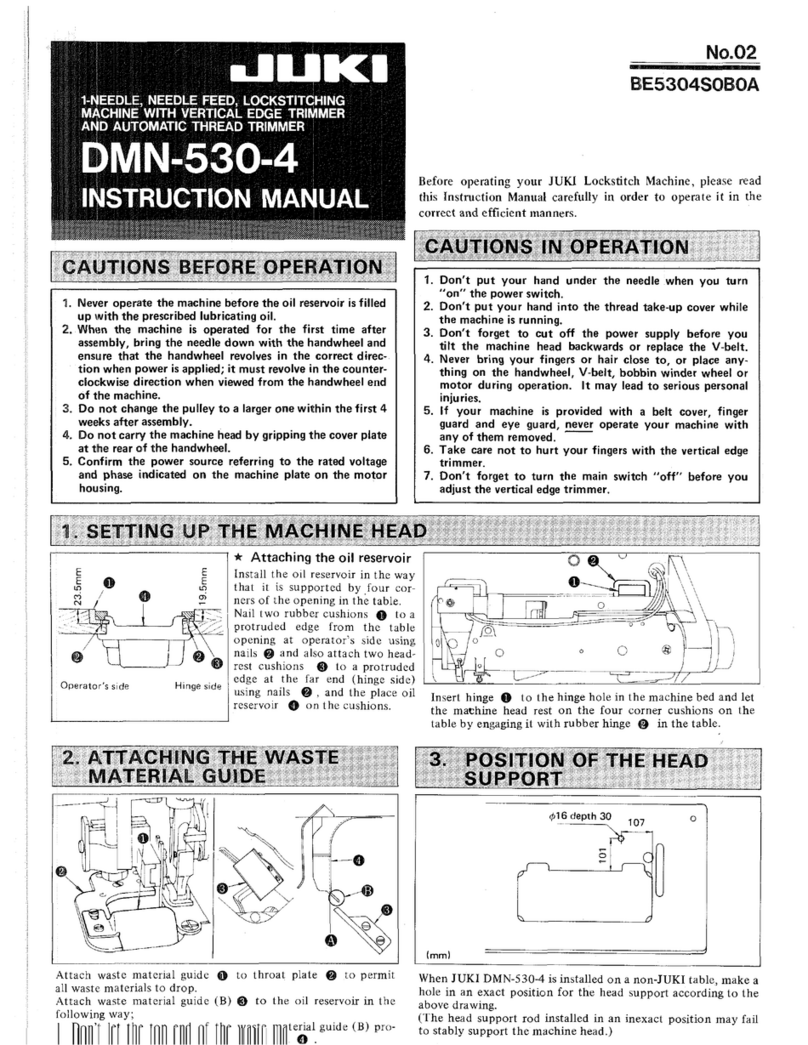iv
5. Besuretoturnthepoweroffandchecktobesurethatthemachineandmotorcompletelystopbeforere-
movingthebeltcoverandV-beltinordertopreventaccidentcausedbyabruptstartofthemachineormotor.
6. Ifaservomotorisusedwiththemachine,themotordoesnotproducenoisewhilethemachineisatrest.
Besurenottoforgettoturnthepoweroffinordertopreventaccidentcausedbyabruptstartofthemotor.
7. Neverusethemachinewiththecoolingopeningofthemotorpowerboxshieldedinordertopreventre
accidentbyoverheat.
Lubrication
1. BesuretouseJUKIgenuineoilandJUKIgenuinegreasetothepartstobelubricated.
2. Iftheoiladheresonyoureyeorbody,besuretoimmediatelywashitoffinordertopreventinamma-
tionorirritation.
3. Iftheoilisswallowedunintentionally,besuretoimmediatelyconsultamedicaldoctorinordertopre-
ventdiarrheaorvomiting.
Maintenance
1. Inpreventionofaccidentcausedbyunfamiliaritywiththemachine,repairandadjustmenthastobe
carriedoutbyaservicetechnicianwhoisthoroughlyfamiliarwiththemachinewithinthescopedened
intheinstructionmanual.BesuretouseJUKIgenuinepartswhenreplacinganyofthemachineparts.
JUKIassumesnoresponsibilityforanyaccidentcausedbyimproperrepairoradjustmentortheuseof
anypartotherthanJUKIgenuineone.
2. Inpreventionofaccidentcausedbyunfamiliaritywiththemachineorelectrical-shockaccident,besure
toaskanelectricaltechnicianofyourcompanyorJUKIordistributorinyourareaforrepairandmainte-
nance(includingwiring)ofelectricalcomponents.
3. Whencarryingoutrepairormaintenanceofthemachinewhichusesair-drivenpartssuchasanaircyl-
inder,besuretoremovetheairsupplypipetoexpelairremaininginthemachinebeforehand,inorderto
preventaccidentcausedbyabruptstartoftheair-drivenparts.
4. Besuretocheckthatscrewsandnutsarefreefromloosenessaftercompletionofrepair,adjustment
andpartreplacement.
5. Besuretoperiodicallycleanupthemachineduringitsdurationofuse.Besuretoturnthepoweroff
andverifythatthemachineandmotorstopcompletelybeforecleaningthemachineinordertoprevent
accidentcausedbyabruptstartofthemachineormotor.
6. Besuretoturnthepoweroffandverifythatthemachineandmotorstopcompletelybeforecarryingout
maintenance,inspectionorrepairofthemachine.(Forthemachinewithaclutchmotor,themotorwill
keeprunningforawhilebyinertiaevenafterturningthepoweroff.So,becareful.)
7. Ifthemachinecannotbenormallyoperatedafterrepairoradjustment,immediatelystopoperationand
contactJUKIorthedistributorinyourareaforrepairinordertopreventaccidentthatcanresultinper-
sonalinjuryordeath.
8. Ifthefusehasblown,besuretoturnthepoweroffandeliminatethecauseofblowingofthefuseand
replacetheblownfusewithanewoneinordertopreventaccidentthatcanresultinpersonalinjuryor
death.
9. Besuretoperiodicallycleanuptheairventofthefanandinspecttheareaaroundthewiringinorderto
preventreaccidentofthemotor.
Operatingenvironment
1. Besuretousethemachineundertheenvironmentwhichisnotaffectedbystrongnoisesource(electro-
magneticwaves)suchasahigh-frequencywelderinordertopreventaccidentcausedbymalfunctionof
themachine.
2. Neveroperatethemachineinanyplacewherethevoltageuctuatesbymorethan"ratedvoltage±10%"
inordertopreventaccidentcausedbymalfunctionofthemachine.
3. Besuretoverifythattheair-drivendevicesuchasanaircylinderoperatesatthespeciedairpressure
beforeusingitinordertopreventaccidentcausedbymalfunctionofthemachine.
4. Tousethemachinewithsafety,besuretouseitundertheenvironmentwhichsatisesthefollowing
conditions:
Ambienttemperatureduringoperation 5°Cto35°C
Relativehumidityduringoperation 35%to85%
5. Dewcondensationcanoccurifbringingthemachinesuddenlyfromacoldenvironmenttoawarmone.
So,besuretoturnthepoweronafterhavingwaitedforasufcientperiodoftimeuntilthereisnosign
ofwaterdropletinordertopreventaccidentcausedbybreakageormalfunctionoftheelectricalcompo-
nents.
6. Besuretostopoperationwhenlightningashesforthesakeofsafetyandremovethepowerplugin
ordertopreventaccidentcausedbybreakageormalfunctionoftheelectricalcomponents.
7. Dependingontheradiowavesignalcondition,themachinemaygeneratenoiseintheTVorradio.Ifthis
occurs,usetheTVorradiowithkeptwellawayfromthemachine.
8. Inordertoensuretheworkenvironment,locallawsandregulationsinthecountrywherethesewing
machineisinstalledshallbefollowed.
Inthecasethenoisecontrolisnecessary,anearprotectororotherprotectivegearshouldbewornac-
cordingtotheapplicablelawsandregulations.
9. Disposalofproductsandpackagesandtreatmentofusedlubricatingoilshouldbecarriedoutproperly
accordingtotherelevantlawsofthecountryinwhichthesewingmachineisused.
– 17 –
2. Installation process
1) Fit spring over screw . In this state, x
feed bar hinge stud .
2) Attach feed driving pin in place.
3) Attach feed bar block A on feed bar oscil-
lating arm .
4) Attach feed bar block shaft on feed bar .
5) Attach feed bar block B in feed bar block
shaft using E ring .
6) Attach feed on feed bar with feed set-
screw .
7) Attach feed bar block shaft and feed bar
on which feed has been attached in place
on feed bar hinge stud .
8) Install spring support shaft in place.
9) Tighten feed setscrew to allow the needle
to come just at the center of the needle hole
in the feed .
10) Top cover spring of the bed,feed bar shaft
cover and screw of the feed bar shaft
cover in place.
11) Fix top cover of the bed by tightening
screw in the top cover of the bed.
12) Attach throat plate in place and x it using
screw of the throat plate.
13) Install presser foot (asm.) and walking foot
in place.
(Caution)
1.The parts attached with an asterisk ( * ) are the exclusive parts for the DSC-245V-4 or -7.
2.The feed driving pin has engraved marker lines. Use the pin which has many marker lines to raise the feed dog,or
use the pin with less marker lines to lower it.
Note No. Part No. Part Name Q'ty Remarks
22 B15242450A0 Presser foot (asm.) 1
23 B1470245000 Walking foot 1
24 SS2110915SP Screw in throat plate 2 11/64 40 thread ridges, L=8.5
25 B1105245000 Throat plate 1
* D1105245E00 Throat plate 1
26 SS2090710TP Screw in top cover of bed 1 9/64 40 thread ridges, L=7
27 B1173245000 Top cover of bed 1
* D1173245E00 Top cover of bed 1
28 B1175245000 Spring of top cover of bed 1
29 B1613245000 Feed 1
* D1613245E0A Feed 1
30 B1645245000 Feed bar block 1
31 RE0300000K0 E ring 1
32 B1644245000 Feed bar block B 1
33 B1643145000 Feed bar block A 1
34 B163224500C Feed driving pin 1 Selective part (caution 2)
35 B1641245000 Feed bar hinge stud screw 2
36 B1642245000 Feed bar hinge stud screw spring 2
List of parts to be replaced
Part No. B163224500A B163224500B B163224500C B163224500D B163224500E
Length(mm) 5.7±0.05 5.9±0.05 6.1±0.05 6.3±0.05 6.5±0.05
Number of marker lines 1 2 3 4 5
